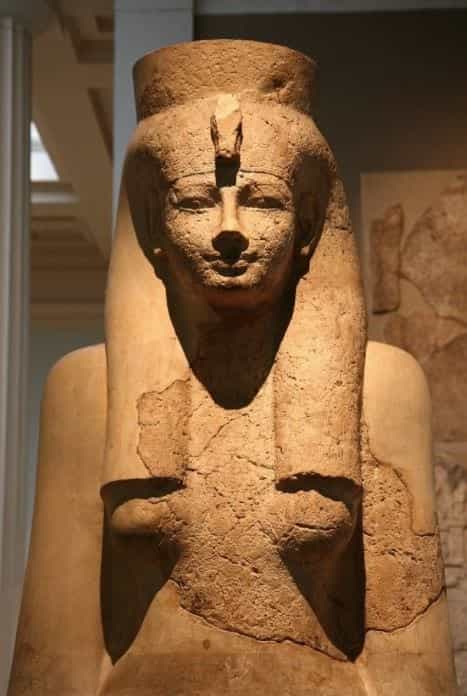In the ancient city of Thebes, known in antiquity as Ipet-Sut, meaning “the chosen place” or “the one who gave birth to the gods,” we find the majestic temples dedicated to Amun, Khonsu, and Mut. This city served as the sacred center of the Theban triad, where Mut’s presence embodied the divine feminine, alongside her consort Amun and her son Khonsu.
Mut, often regarded as the “Mother of the Gods” and the creator of the world, is intrinsically connected to the goddess Sekhmet. As a lioness deity, Sekhmet symbolizes the dual nature of Mut’s femininity—balancing fierce protection and healing. Together, these qualities portray Mut as both a nurturing and powerful force in the cosmic order.
Emerging from the Primordial Waters, Mut is a manifestation of life’s hidden mysteries, influencing the visible realm and ensuring the maintenance of the cosmic balance. Her role alongside Amun was crucial in sustaining order in the universe and reflecting it on earth.
While Mut’s worship can be traced back to the Middle Kingdom, her significance grew after the unification of Upper and Lower Egypt. She embodied the unity of the two lands and reached a peak in her veneration during the New Kingdom, when her status as a goddess with attributes from both regions became prominent.
As a mother goddess, Mut’s divine offspring included Khonsu, the lunar deity, and Montu, the god of war. Her most important cult center was at Karnak, where her temple stood close to that of Amun. However, her influence extended beyond Karnak, reaching other sacred sites throughout Egypt.
In artistic depictions, Mut is portrayed with the double crown symbolizing Upper and Lower Egypt, along with a vulture headdress, a papyrus scepter, and the Ankh, symbolizing life. As a celestial deity, she sometimes takes the form of a vulture, clutching a magical knot in her talons, or appears as a cow, representing fertility, often associated with Amun.
Mut’s mythological significance extends to her origins as a primordial goddess emerging from the Nun, the chaotic waters of creation. She is described as “the strong bow, the one who was with Nun,” a mother who gave birth to herself and became a powerful deity in her own right. This self-creation emphasizes her role as a great mother figure, a nurturer of the cosmos.
During the 18th dynasty of the New Kingdom, Mut’s worship gained prominence, gradually supplanting the earlier goddess Amonet as the consort of Amun in Thebes. Amonet, known as the goddess of mystery and the unseen, was a protective and ancient deity who embodied the north wind, a life-giving force. Her imagery often featured her as either a serpent or a woman with a serpent’s head, symbolizing her mysterious and primordial nature.
Mut’s associations extended to other powerful goddesses, including Neit, the Great Mother and divine creator. Neit was depicted as a cow who gave birth to the sun god Ra and was known as a serpent goddess who measured the earth. Her connection with childbirth, the vital breath of life, and her role as a life-giver further intertwined with Mut’s identity as a primordial mother.
In her many roles, Mut was recognized as the mother goddess who took on various forms and attributes, often blending with other deities. She was closely linked with Hathor, the goddess of love, music, and motherhood, but also displayed a fiercer aspect as a lioness. When depicted in this form, she merged with Sekhmet, embodying the destructive power needed to restore balance whenever the created order was threatened.










